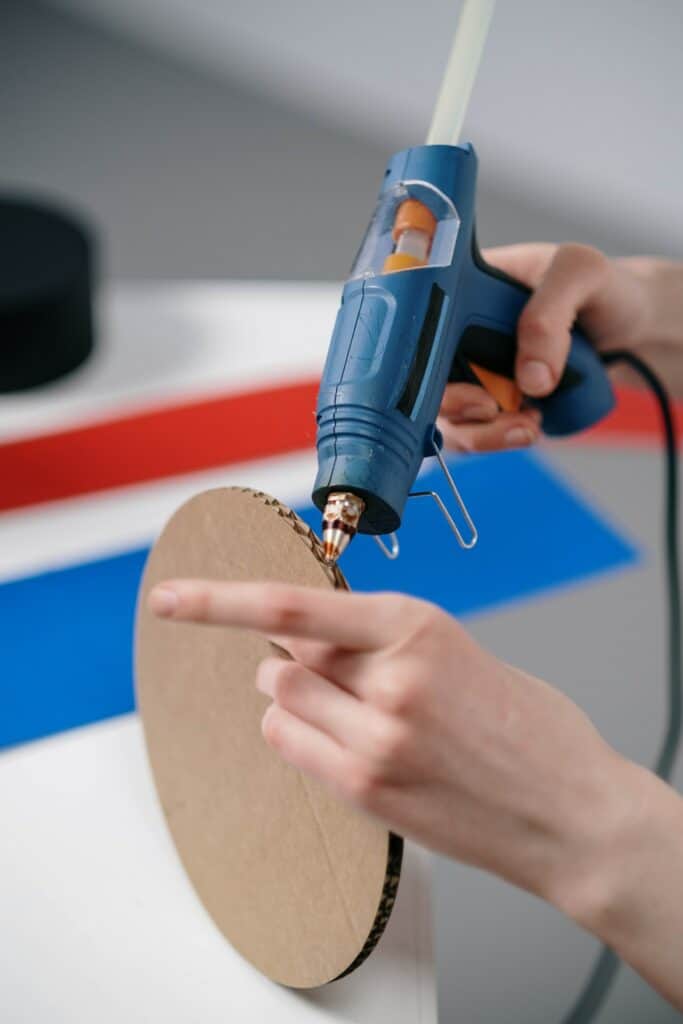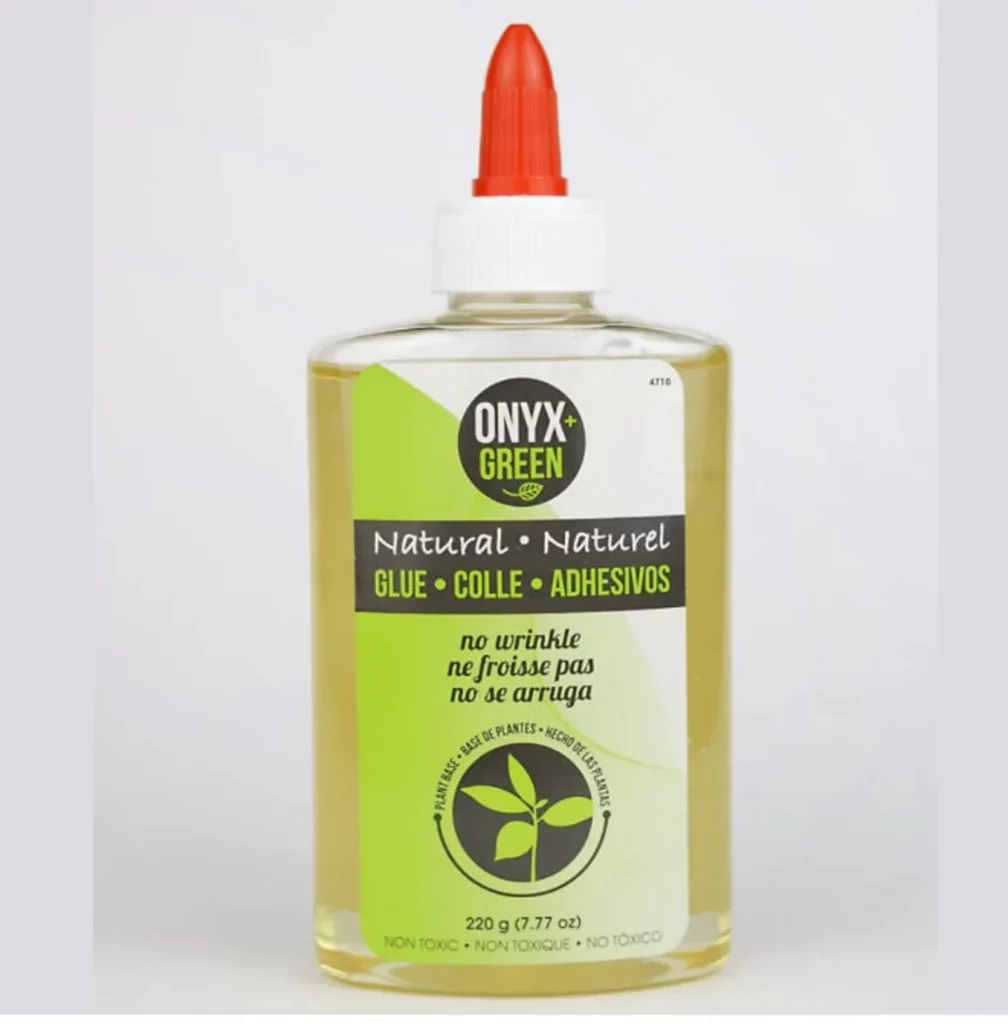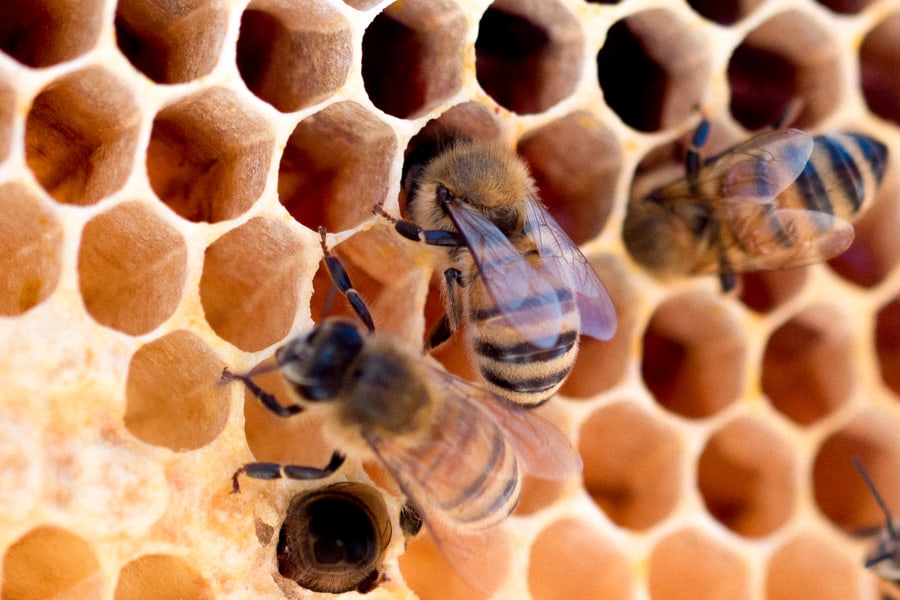Is glue vegan? While most modern glues are synthetic, some adhesives are animal-derived—either through collagen, a protein in the connective tissue of animals, or the horns or hooves of mammals. Some plant-based alternatives exist, usually made from starch or cellulose. So, it depends on the type of glue you’re using.
But even with this awareness, the lack of transparency in the glue supply chain makes it incredibly difficult to avoid non-vegan glues. Glue is used in many products, and manufacturers don’t generally disclose if their glue is animal-derived.
And from a moral perspective, many wonder if animals are directly exploited in producing glue. For example, are horses killed to make glue, or are we extracting their body parts after they naturally die?
There’s a lot to unpack here, but understanding the evolution of glue technology is a helpful starting point.
What is glue?
Glue is a sticky substance that’s used to stick two surfaces together. It’s made up of long chain molecules that are attracted to both the surfaces being glued to each other.
When applying glue, the molecules will spread out and bond with the surface, forming a thin layer that holds the two surfaces together.
According to ThoughtCo, archaeologists excavating burial sites from 4000 BC have discovered clay pots repaired with glue made from tree sap. This proves that even in early times, people used adhesives to repair broken objects.
We know that the ancient Greeks developed adhesives to use in carpentry and created recipes for glue that included egg whites, blood, bones, milk, cheese, vegetables, and grains. The Romans used tar and beeswax in adhesives.
Around 1750, the first glue patent was issued in Britain containing natural rubber, animal bones, fish, starch, and milk protein, or casein.
Hoof glue is another type of animal glue made by boiling down the hooves of large mammals into a protein source called keratin.
Then we have horn glue, an adhesive made from animal horn shavings. It has been used for centuries for various purposes, including woodworking, leatherwork, and taxidermy.
With the development of synthetic polymers in the 20th century, adhesives became even more versatile and powerful. Today, we use adhesives in various applications, from building cars to affixing pictures to our walls. Adhesives have truly revolutionised the way we live and work.
Modern manufacturing techniques have resulted in various adhesives designed for specific purposes. For example, some glues are designed to be strong and durable, while others are designed to be easily removable.
Regardless of the adhesive, the manufacturing process generally involves mixing the ingredients and heating them until they form a sticky liquid. The liquid is then cooled and formed into the desired shape before being packaged for sale.
Fortune Business Insights predicts the global market for adhesives and sealants will grow from $62.63 billion in 2021 to $92.29 billion by 2029. This reflects the increasing demand for products that can be used to bind a variety of materials.

Is glue really made from horses?
No, not anymore. Horses were once a top target for making glue because of their high protein content and access to their hooves. During the 18th and 19th centuries, ranchers disposed of horses to glue factories.
However, with the proliferation of cattle farming, animal-derived adhesives are mainly sourced from cows and pigs. The idea here is that there are already many “waste products” in agriculture, so using those rather than specially bred animals for their collagen is more efficient.
I couldn’t find concrete evidence of horse collagen being used today to produce glue. However, horse collagen still plays a role in the medical industry. It’s commonly used in wound dressings and is being studied for its potential uses in treating arthritis, tendonitis, and other conditions.
Are animals explicitly killed for making glue?
Most glue is made from synthetic materials, so animals are not killed specifically to make glue. But as we’ve established, some adhesives are still made from animal flesh, skin, and bone.
A common argument is that collagen, hooves, and horns are extracted from animals already used for meat, dairy, and skin. However, the animal glue industry is still worth billions of dollars, so glue profits represent a portion of companies’ overall revenue.
Sure, you could say that using the entire carcass is the most efficient “use” of breeding and slaughtering animals for human consumption. But glue is still a separate industry with its own supply chain and distribution. So glue, in this context, is a co-product of the meat industry.
While it’s admittedly not the most direct use of animals raised for food production, it’s still an essential part of the industry—one that should be considered when evaluating the ethical implications of animal welfare.
What about vegan glue?
There are several cruelty-free alternatives to animal-based adhesives, such as plant-based glues made from vegetables, fruits, and grains.
One type of plant-based adhesive is cellulose glue, made from the cell walls of plants. This type of glue is often used in the food industry.
Another type of plant-based adhesive is starch glue, made from the starch found in potatoes, wheat, and corn. This type of glue is often used in the paper industry.
Then there are synthetic adhesives, which are made from petroleum-based polymers. Synthetic glues are cheaper to produce and dominate the adhesive market.
Cruelty-free adhesives are just as effective as their animal-based counterparts, but without the suffering.
For this reason, it is vital to support companies that use cruelty-free ingredients in their products. Doing so can help reduce the demand for animal-based adhesives.
How to find vegan glue?
For vegans, glue presents a dilemma as brands are not always transparent about their ingredients and manufacturing processes.
One option is to look for glues that are marketed explicitly as plant-based. These products will usually list their ingredients on the packaging. In my experience, such packaging is rare.

Alternatively, a little digging should reveal whether or not a particular glue is suitable for use by vegans. Steer clear of any product if it contains these animal-derived ingredients:
- Collagen: a protein found in animal skin, tendons, and bones. It is often used as a binding agent in glues.
- Gelatine: a protein made from boiling animals’ skin, connective tissue, and bones. It is often used as a thickening agent in glues.
- Bone meal: a powder made from grinding up animal bones. It’s often used as a filler in glues.
- Blood meal: a powder made from drying and grinding up animal blood—used as a fertiliser or protein supplement but can also be found in some glues.
- Casein: a protein found in animal milk—generally used as a binding agent in glues.
- Isinglass: A type of gelatin made from fish swim bladders used as a clarifying agent in glue and wine.
- Shellac: a resin made from the secretions of insects—used as a sealant or coating in glues.
- Albumen: a protein found in egg whites. It’s often used as a binding agent in glues.
If you’re ever unsure whether a particular glue is vegan, err on the side of caution and choose another product. There are plenty of cruelty-free adhesives on the market, so you’re sure to find one that meets your needs.
Finally, when researching a product, contact the brand to ask if their glue contains animal products. If they don’t know, see if you can at least get the brand of glue that they use so you can cross-check yourself.
What glues are made from animals?
If you’re wondering if Elmer’s or UHU glue is cruelty-free, you’re in luck. Most household glue brands are synthetic and cruelty-free.
Here are some of the renowned glue products on the market:
| Product | Vegan-Friendly | Source |
| Gorilla Super Glue | Yes | I’m Going Vegan |
| UHU Glue Stick | Yes | Universal Art Supplies |
| Elmers School Glue | Yes | Vegan Foundry |
| Titebond Wood Glue | Yes | I’m Going Vegan |
I highly recommend reading I’m Going Vegan’s glue guide to getting a backstory on some of the most prominent glue brands.
So, is glue vegan? Final thoughts
While some glues are made from ingredients like plant starches and other vegetable-based products, and others contain casein or collagen from animals, most glues today are synthetic.
If you’re looking for an animal-free adhesive alternative, plenty of cruelty-free glue on the market will work just as well, if not better.
Have you had trouble finding a good glue that doesn’t use animals? Let me know in the comments below.






Thanks for this article, it is great. As the Australian Programmes Manager for Cruelty Free International, I am still concerned that many vegan art and craft supplies, that although may be vegan friendly, meaning not containing animal product, doesn’t automatically mean that these vegan ingredients, whether synthetic or natural origin, are not being tested on animals for toxicity tests. This is something that sadly is very common. I am unable to find mention of anything to do with animal testing or not for example on UHU’s website.
I’m old enough that I still think of horses every time I think of glue. I’m grateful for that imprinting, but it’s something that, until now, I hadn’t thought beyond. Love this resource.
This was interesting and something I never thought about.
very interesting article. I had never considered the question of whether glue was vegan so thanks for informing me. You mentioned ways to tell how household glue is vegan or not but do you have any suggestions w/ regards to used to produce products such as sneakers or books?
thanks
jacquie
Hi Jacquie, pre-made products using glue is a tough one. I’ve resorted to emailing the brands when purchasing notebooks and shoes. As for books, it hasn’t seemed practical to follow up—so I take it at face value.
thanks for getting back to me and in terms of brands will start doing the same. With regards to books, i wish there was a vegan bookmaker. Perhaps someday….